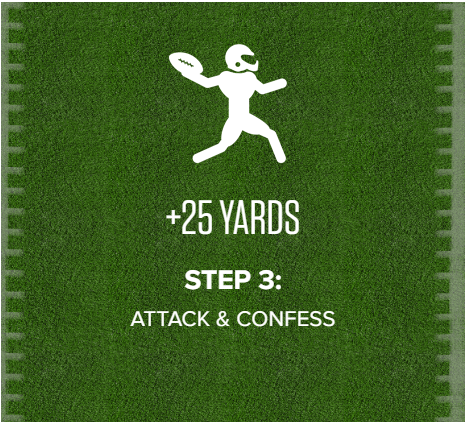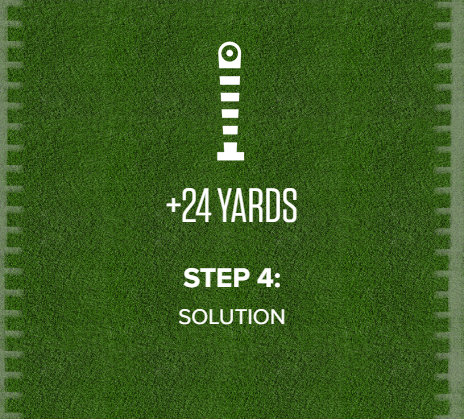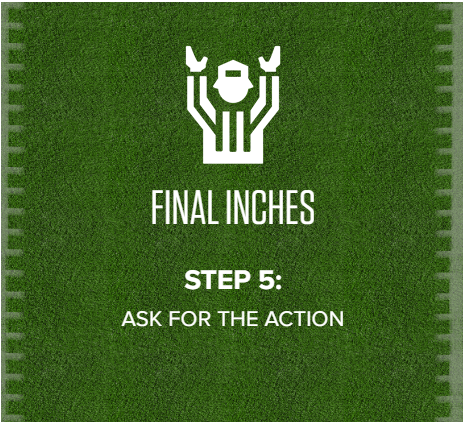“We Create Breakthroughs"
Wealth Mastery virtual
Have you ever noticed that many of life's greatest GIFTS come disguised in the cloak of our PROBLEMS? What if our problems are actually our greatest gifts?
HOW CAN I COMMUNICATE MORE EFFECTIVELY?
What you will learn from reading this article:
What does football have to do with learning how to communicate effectively?
Building rapport with others is the cornerstone of getting people on your side. But there’s more to establishing rapport than just mirroring – don’t worry, we’ll cover how that works, too – there’s also the order you unroll your message. Having trouble making connections in your personal or professional life? Follow this model for effective communication and you’ll be able to score a touchdown when making an ask, whether it’s pitching your business to an investor, getting a raise or even asking a friend or loved one for a favor.
Just like on the football field, the last few inches before you reach the end zone can be the hardest to travel. But the rewards of effective, consistent communication patterns? Astounding. Here’s how to get yourself down the field using effective communication.
- How to get people to say “yes” using Tony Robbins’ powerful football field model for effective communication
- The 5 steps for great communication: build rapport, use logic, anticipate objections, identify solutions and ask for action
- The exact amount of time to devote to each step of the process, including the final step of specific commitment
- Discover Mastering Influence and take your communication skills to the next level
What does football have to do with learning how to communicate effectively?
Building rapport with others is the cornerstone of getting people on your side. But there’s more to establishing rapport than just mirroring – don’t worry, we’ll cover how that works, too – there’s also the order you unroll your message. Having trouble making connections in your personal or professional life? Follow this model for effective communication and you’ll be able to score a touchdown when making an ask, whether it’s pitching your business to an investor, getting a raise or even asking a friend or loved one for a favor.
Just like on the football field, the last few inches before you reach the end zone can be the hardest to travel. But the rewards of effective, consistent communication patterns? Astounding. Here’s how to get yourself down the field using effective communication.
EFFECTIVE COMMUNICATION MEANS THINKING IN PATTERNS
The key to winning people over and getting them to give an enthusiastic yes to your proposals is understanding how communication models actually work. How are you connecting with those around you? Are you practicing good communication or just projecting an unimportant message? Is your message really being received? What communication style are you using to convey your message?
Tony’s model of a football field that we outline here shows not just how to communicate effectively with the most powerful order for crafting your message, but also how much time should be devoted to each step of the communication process. The yardage shows you what proportion each step takes, so 40 yards = 40% of the total communication time.

STEP 1: BUILD IDENTIFICATION AND RAPPORT (+40 YARDS)
Sometimes you instantly have a good rapport with someone; other times, it takes time and effort to develop. Rapport comes from feeling like we have something in common with another person, and making the most of that good energy. When we think we have things in common, we’re more comfortable; when we’re more comfortable, the more we enjoy being with others. Building rapport includes asking questions that are the backbone of small talk: Where people come from, what they do and uncovering any shared commonalities or interests.
But the real secret of building rapport lies in how you nonverbally communicate with people. How you use your body makes up 93% of what people respond to, so its critical for effective communication. This is why mirroring – where you match someone’s body movements, energy level, even breathing pattern – is a widely used technique to get people on your side. Start by following the person’s movements as a way to establish a connection. Are their legs crossed? Cross yours. Do they talk with their hands? Do the same. A quick test for physical rapport is changing your own position and seeing if they follow your lead. If so, you’re generating major rapport. If not, keep mirroring and try again a little later.
With this first step, you’re creating the solid foundation you need to get your audience to identify with you. You’re connecting with your audience and establishing trust. This step takes the most time and is the most important part of quality communication. Your goal is to get your audience to identify and relate to you (and your message) right up front. You want them thinking, “Me too” as they process your message, instead of saying, “So what?”
You often see politicians use these techniques. It’s why, to connect with voters, they talk about their childhood or struggles they’ve overcome. If you’re able to get whoever you’re talking to, whether it’s one person or a whole auditorium, to subconsciously think “Yes, yes, yes,” then you’re well on your way to mastering Step 2 of how to communicate effectively.

STEP 2: LOGIC & REASON (+10 YARDS)
With your audience on your side, it’s now time to bring out the facts or the basis of your point. What’s the core message you need to get across? You’ll want to give them just enough of the details to justify an emotional decision. Remember: People make many decisions for emotional reasons, but to create sustainable choices, they always need to be able to justify them with logic. Help your cause by giving them the logic they need up front to create this justification. Laying out your details and facts up front also proves that you can provide the solution they seek, and can express your message clearly, which establishes you as a credible source for whatever you’re advocating.
Quick word of warning: Launching into dry details in an attempt to offer logical justification will likely kill the rapport you’ve built thus far. Instead of listing facts and statistics, integrate your information naturally and continue to practice engagement. Combining informative and entertaining information is key to engaging your audience. Now that you’ve accomplished this step, guess what? You’re already halfway down the field!
With your audience on your side, it’s now time to bring out the facts or the basis of your point. What’s the core message you need to get across? You’ll want to give them just enough of the details to justify an emotional decision. Remember: People make many decisions for emotional reasons, but to create sustainable choices, they always need to be able to justify them with logic. Help your cause by giving them the logic they need up front to create this justification. Laying out your details and facts up front also proves that you can provide the solution they seek, and can express your message clearly, which establishes you as a credible source for whatever you’re advocating.
Quick word of warning: Launching into dry details in an attempt to offer logical justification will likely kill the rapport you’ve built thus far. Instead of listing facts and statistics, integrate your information naturally and continue to practice engagement. Combining informative and entertaining information is key to engaging your audience. Now that you’ve accomplished this step, guess what? You’re already halfway down the field!

STEP 3: ATTACK & CONFESS (+25 YARDS)Here you do two things:
- Anticipate possible objections. You’re never going to enter a room where everyone agrees with you 100%. By articulating the possible objections your audience could have, you show empathy and intelligence. Chances are, you learned this on your high school debate team or in speech class – it’s a tried and true effective communication technique for winning people over. By anticipating objections and preparing yourself for any counter-arguments that may come up, you’re also strengthening your own point of view and demonstrating that you know your point inside and out to your audience.
- Show the consequences. Claim that you had the same objections initially and attack yourself for it. In this phase your outcome is for the audience to realize the “hell if they don’t”– what is the consequence to them if they don’t follow through/take your suggestion? One way to accomplish this step is relating what happened to you before you took action. Providing an anecdote can do away with the audience’s doubt while simultaneously making you seem more relatable.

STEP 4: SOLUTION (+24 YARDS)
You’re almost to the end! Now it’s time to lay out your solution to the challenges you just brought up in Step 3. Instead of a vision of hell, you’re showing a vision of heaven. Help whoever you’re talking to think about all the positives and benefits they’ll receive if they take action/follow through. Another pro tip: Use the negative consequences for contrast – they’ll make the positives seem even better by comparison.
Now is the time to pick up the pace so that you gather enough momentum for the final step that effective communication requires.
You’re almost to the end! Now it’s time to lay out your solution to the challenges you just brought up in Step 3. Instead of a vision of hell, you’re showing a vision of heaven. Help whoever you’re talking to think about all the positives and benefits they’ll receive if they take action/follow through. Another pro tip: Use the negative consequences for contrast – they’ll make the positives seem even better by comparison.
Now is the time to pick up the pace so that you gather enough momentum for the final step that effective communication requires.

STEP 5: ASK FOR THE ACTION (FINAL INCHES)
Finally, you ask for the action you want. What was it that you wanted your audience to do? Are you asking them to buy a product, care about a cause or donate their time or money? Are you communicating with your partner about making a major financial decision? By this point your audience is sold on the power of following through – you’ve highlighted the things that make your solution logical and made your audience feel good by connecting with them. However, don’t take it for granted that they’ll always come along – ask for follow-through by requesting a specific commitment. That could be something as simple as a phone call or an email address or on the scale of a major investment, like their money and/or time. This last step shows you how effective your communication has been; now get out there and do it again!
Finally, you ask for the action you want. What was it that you wanted your audience to do? Are you asking them to buy a product, care about a cause or donate their time or money? Are you communicating with your partner about making a major financial decision? By this point your audience is sold on the power of following through – you’ve highlighted the things that make your solution logical and made your audience feel good by connecting with them. However, don’t take it for granted that they’ll always come along – ask for follow-through by requesting a specific commitment. That could be something as simple as a phone call or an email address or on the scale of a major investment, like their money and/or time. This last step shows you how effective your communication has been; now get out there and do it again!
